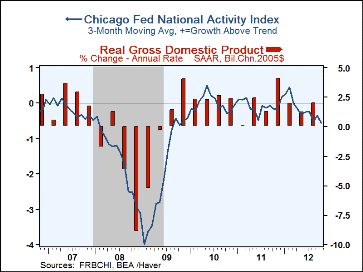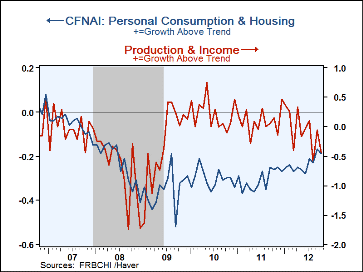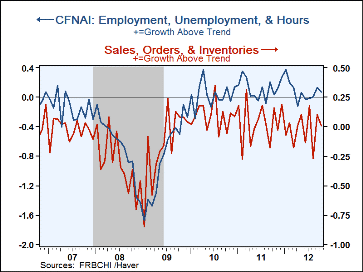 Global| Nov 26 2012
Global| Nov 26 2012U.S. Chicago Fed Index Drops Sharply
by:Tom Moeller
|in:Economy in Brief
Summary
The Chicago Federal Reserve reported that its National Activity Index (CFNAI) for October dropped sharply to -0.56 from an unrevised 0.00 during September. The three-month moving average also fell to -0.56, its lowest since October [...]
 The Chicago Federal Reserve reported that its National Activity Index
(CFNAI) for October dropped sharply to -0.56 from an unrevised 0.00 during
September. The three-month moving average also fell to -0.56, its lowest
since October 2009. During the last ten years, there has been an 81%
correlation between the Chicago Fed Index and the q/q change in real GDP.
The Chicago Federal Reserve reported that its National Activity Index
(CFNAI) for October dropped sharply to -0.56 from an unrevised 0.00 during
September. The three-month moving average also fell to -0.56, its lowest
since October 2009. During the last ten years, there has been an 81%
correlation between the Chicago Fed Index and the q/q change in real GDP.
Deterioration in the CFNAI reflected declines in all four component series, but it was most notable in the Production & Income number. It dropped to -0.45 and gave back most of its September improvement. The Sales, Inventories & Orders series also declined sharply m/m but remained barely positive. In addition, the Employment, Unemployment & Hours series fell hard but it too remained positive. The Personal Consumption & Housing series dipped and remained negative. In this series, however, the recent trend has been improving while the others have moved sideways or deteriorated. The Chicago Fed reported that during October, 31 of the 85 individual indicators made positive contributions to the index while 54 made negative contributions.
The CFNAI is a weighted average of 85 indicators of national economic activity. It is constructed to have an average value of zero and a standard deviation of one. Since economic activity tends toward trend growth rate over time, a positive index reading corresponds to growth above trend and a negative index reading corresponds to growth below trend.
The Chicago Federal Reserve figures are available in Haver's SURVEYS database.
| Chicago Federal Reserve Bank | Oct | Sep | Aug | Oct '11 | 2011 | 2010 | 2009 |
|---|---|---|---|---|---|---|---|
| CFNAI | -0.56 | 0.00 | -1.13 | 0.07 | 0.03 | -0.01 | -1.63 |
| 3-Month Moving Average | -0.56 | -0.36 | -0.52 | -0.17 | -- | -- | -- |
| Personal Consumption & Housing | -0.19 | -0.17 | -0.23 | -0.26 | -0.31 | -0.30 | -0.35 |
| Employment, Unemployment & Hours | 0.07 | 0.13 | 0.00 | 0.03 | 0.12 | 0.03 | -0.82 |
| Production & Income | -0.45 | -0.06 | -0.62 | 0.05 | 0.09 | 0.22 | -0.29 |
| Sales, Orders & Inventories | 0.01 | 0.10 | -0.27 | 0.16 | 0.04 | 0.09 | -0.16 |
Tom Moeller
AuthorMore in Author Profile »Prior to joining Haver Analytics in 2000, Mr. Moeller worked as the Economist at Chancellor Capital Management from 1985 to 1999. There, he developed comprehensive economic forecasts and interpreted economic data for equity and fixed income portfolio managers. Also at Chancellor, Mr. Moeller worked as an equity analyst and was responsible for researching and rating companies in the economically sensitive automobile and housing industries for investment in Chancellor’s equity portfolio. Prior to joining Chancellor, Mr. Moeller was an Economist at Citibank from 1979 to 1984. He also analyzed pricing behavior in the metals industry for the Council on Wage and Price Stability in Washington, D.C. In 1999, Mr. Moeller received the award for most accurate forecast from the Forecasters' Club of New York. From 1990 to 1992 he was President of the New York Association for Business Economists. Mr. Moeller earned an M.B.A. in Finance from Fordham University, where he graduated in 1987. He holds a Bachelor of Arts in Economics from George Washington University.








